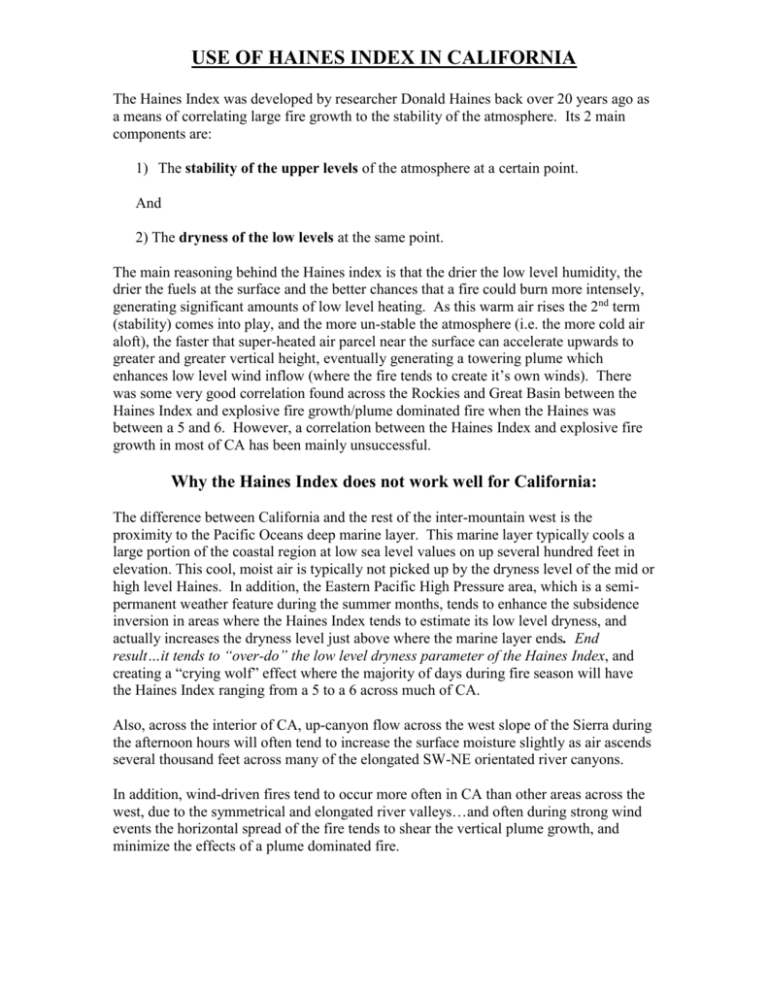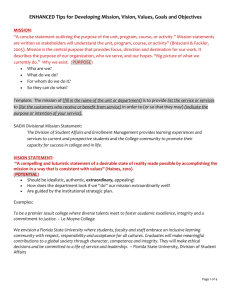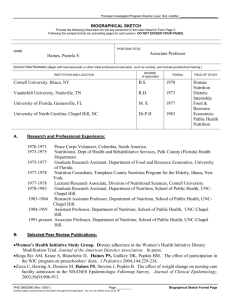USE OF HAINES INDEX IN CALIFORNIA
advertisement

USE OF HAINES INDEX IN CALIFORNIA The Haines Index was developed by researcher Donald Haines back over 20 years ago as a means of correlating large fire growth to the stability of the atmosphere. Its 2 main components are: 1) The stability of the upper levels of the atmosphere at a certain point. And 2) The dryness of the low levels at the same point. The main reasoning behind the Haines index is that the drier the low level humidity, the drier the fuels at the surface and the better chances that a fire could burn more intensely, generating significant amounts of low level heating. As this warm air rises the 2nd term (stability) comes into play, and the more un-stable the atmosphere (i.e. the more cold air aloft), the faster that super-heated air parcel near the surface can accelerate upwards to greater and greater vertical height, eventually generating a towering plume which enhances low level wind inflow (where the fire tends to create it’s own winds). There was some very good correlation found across the Rockies and Great Basin between the Haines Index and explosive fire growth/plume dominated fire when the Haines was between a 5 and 6. However, a correlation between the Haines Index and explosive fire growth in most of CA has been mainly unsuccessful. Why the Haines Index does not work well for California: The difference between California and the rest of the inter-mountain west is the proximity to the Pacific Oceans deep marine layer. This marine layer typically cools a large portion of the coastal region at low sea level values on up several hundred feet in elevation. This cool, moist air is typically not picked up by the dryness level of the mid or high level Haines. In addition, the Eastern Pacific High Pressure area, which is a semipermanent weather feature during the summer months, tends to enhance the subsidence inversion in areas where the Haines Index tends to estimate its low level dryness, and actually increases the dryness level just above where the marine layer ends. End result…it tends to “over-do” the low level dryness parameter of the Haines Index, and creating a “crying wolf” effect where the majority of days during fire season will have the Haines Index ranging from a 5 to a 6 across much of CA. Also, across the interior of CA, up-canyon flow across the west slope of the Sierra during the afternoon hours will often tend to increase the surface moisture slightly as air ascends several thousand feet across many of the elongated SW-NE orientated river canyons. In addition, wind-driven fires tend to occur more often in CA than other areas across the west, due to the symmetrical and elongated river valleys…and often during strong wind events the horizontal spread of the fire tends to shear the vertical plume growth, and minimize the effects of a plume dominated fire. USE OF HAINES INDEX IN CALIFORNIA The Haines Index has NOT been shown to be a reliable predictor of large fire potential across much of CA. This has been confirmed by several studies, namely that of Chris Fontana who was a forecaster in Redding for over 30 years, both with the USFS as well as the National Weather Service. When/Where does the Haines Index work in CA? The Haines Index has shown to be fairly reliable only across limited areas in California. Across North Ops, areas that are east of the Sierra/Cascade crest tend to correlate the Haines Index better with large fire growth. The reason seems to be that much of the Pacific moisture tends to be a non factor this far from the coast, and also there is more of a basin topography rather than elongated/symmetrical river canyons where organized wind regimes can often over-run the vertical plume effects associated with a Haines driven fire. This area can be seen within the red hatched regions indicated below. Across Southern CA the inland climatology also fits this role, but a limiting factor is likely the flashier/lighter fuels which burn quickly and spread horizontally much faster, thus eliminating the steady area of surface heat needed to develop a plume dominated fire.









